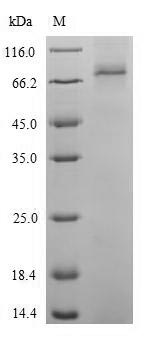Recombinant Arabidopsis thaliana Catalase-2 (CAT2) comes from an E.coli expression system and contains the complete sequence spanning amino acids 1-492. The protein carries an N-terminal 6xHis-SUMO tag that helps with purification, reaching over 90% purity based on SDS-PAGE analysis. This product is intended solely for research purposes and appears to meet strict standards for both purity and consistency, which should provide reliable performance in experimental work.
Catalase-2 (CAT2) serves as a crucial enzyme that breaks down hydrogen peroxide—a byproduct from various metabolic processes—into water and oxygen. In Arabidopsis thaliana, CAT2 seems to play an essential role in shielding cells from oxidative damage. Plant biologists find this enzyme particularly interesting when studying stress responses and how reactive oxygen species get regulated within cells.
Potential Applications
Note: The applications listed below are based on what we know about this protein's biological functions, published research, and experience from experts in the field. However, we haven't fully tested all of these applications ourselves yet. We'd recommend running some preliminary tests first to make sure they work for your specific research goals.
Arabidopsis thaliana CAT2 is a tetrameric enzyme that requires precise folding, proper heme incorporation, correct tetramerization, and specific tertiary structure for its functional activity in hydrogen peroxide degradation. The E. coli expression system cannot provide the eukaryotic folding environment or heme incorporation machinery required for this complex metalloenzyme. The large N-terminal 6xHis-SUMO tag (∼15 kDa) may sterically interfere with the protein's active site, tetramerization interfaces, and heme-binding domains. While the full-length protein (1-492aa) contains all functional domains, the probability of correct folding with functional catalase activity is extremely low without experimental validation of heme incorporation and tetramer formation.
1. In Vitro Catalase Enzyme Activity Assays
This application carries a significant risk without functional validation. Catalase activity requires precise heme incorporation, proper tetramerization, and active site formation that cannot be guaranteed in this expression system. If correctly folded and active (verified through H₂O₂ degradation assays), the protein may be suitable for kinetic studies. If misfolded/inactive (unverified), enzymatic measurements will yield biologically meaningless results.
2. Comparative Plant Catalase Research
Meaningful comparative studies require native enzyme conformation and functional activity. If correctly folded and active (verified), the protein enables valid evolutionary comparisons. If misfolded/inactive (unverified), comparative analyses would yield completely misleading insights about catalase conservation and function across plant species.
3. Antibody Development and Validation
This application is highly suitable as antibody development relies on antigenic sequence recognition rather than functional enzymatic activity. The full-length protein provides comprehensive epitope coverage for generating CAT2-specific antibodies. The high purity (>90%) ensures minimal contamination-related issues.
4. Protein-Protein Interaction Studies
This application carries extreme risk without proper folding and tetramerization validation. Catalase interactions require native tetrameric structure and proper folding. If misfolded/unverified, there is a high risk of non-specific binding or failure to replicate genuine protein interactions. The SUMO tag may create artificial interaction surfaces.
5. Structural and Biophysical Characterization
These studies are essential for determining folding status, but will not reflect native catalase structure. Techniques should include size-exclusion chromatography to assess tetramerization state, circular dichroism spectroscopy to evaluate secondary structure, and heme content analysis. However, the SUMO tag will dominate the protein's physical properties and interfere with high-resolution structural studies.
Final Recommendation & Action Plan
The E. coli-expressed CAT2 with a large SUMO tag is unlikely to be properly folded for functional applications due to the essential requirements for heme incorporation and tetramerization that cannot be met in this expression system. Begin with Application 5 (Structural Characterization) to assess folding quality through SEC (tetramer analysis), CD spectroscopy, and validate catalase activity using H₂O₂ degradation assays. Applications 1, 2, and 4 require rigorous functional validation before proceeding. Application 3 (antibody development) can proceed immediately. For reliable catalase research requiring native functionality, use eukaryotic expression systems that support proper heme incorporation and tetramerization, or consider in vitro heme reconstitution protocols with extensive functional validation.






